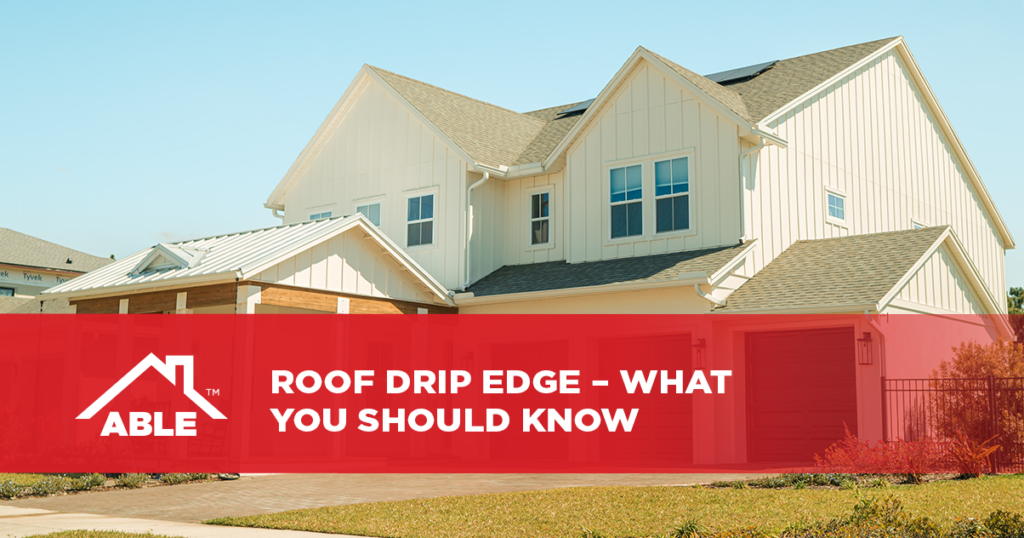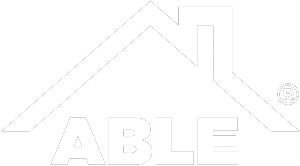Every house has a roof, and yet not everyone is aware of all the important components that make up a functional roof. One of these necessary parts is what’s known as the “drip edge.” Whether or not you’ve heard of it before, you’ve used them all your life. This is because every roof needs one.
What are these drip edges, how do they work, and what would happen if a roof didn’t have one? As a homeowner, these are important questions to understand and know how to answer. Whether or not you’ve ever given this important part of your home any previous thought, you’ll begin to appreciate these necessary edges on every roof.
What drip edges are
A drip edge is a metal flashing installed at the edge of a roof. They come in a few different styles, but all of these styles serve the same function. For the purposes of repair and installation, it’s important to know exactly what the differences are, despite performing the same function.
- A “Type C” edge, also known as “L style,” is the most basic version of the drip edge. Though still acceptable in most cases, it doesn’t have quite as much reach as the other styles.
- A “Type D” edge, also known as “T style,” “D metal,” or “drip metal,” is typically preferred over a Type C because it does a better job of keeping the water away due to its T-like shape.
- A “Type F” edge, known as “F style” or a “gutter apron,” has a longer leading edge. This makes it good for specific situations, like having it hang over house molding.
Regardless of style, the function is basically the same every time – namely, protecting your roof and your home against water damage.
The important function of a drip edge
A drip edge keeps water from getting to the rest of your roof’s components, including the fascia board and roof decking. These pieces of metal redirect the water away from vulnerable parts of your roof and house, protecting it from nasty water damage. They force the water to go instead into your gutter to be safely drained back into the ground or evaporated back into the sky.
Without a drip edge, water would seep into the places it shouldn’t. If it gets into your shingles, for example, then it can get inside your house. Water, if left to sit for long periods of time, creates rot and mold and can cause the foundation of your house to weaken. It can also damage electronics, which in the worst-case scenario, may lead to an electrical fire or outright electrocution. Water damage can be devastating.
In the winter, drip edges also help you avoid problems with ice. Not only is it heavy and cold, but when it melts, it turns into more water. A drip edge, then, protects your roof from ice buildup.
Additionally, they seal up cracks in the roof that could otherwise allow animals inside. Pests might not be as awful as water damage, but they can still create problems. They can spread disease, eat your food, chew on the walls, and multiply like crazy. If a squirrel, chipmunk, or even a bat ends up in your attic, this will lead to a lot of frustration and potential issues later.
In short, your drip edge exists to protect you from the bad things that can happen if your roof isn’t as defensive as it should be. They’re incredibly vital for the overall safety of your roof and home. Conversely, not having one can lead to serious trouble.
Luckily, drip edges are a required part of our homes, thanks to building codes. Drip edges are required due to the nature of the kinds of problems that can occur if they are not present. As a result, your drip edge will need replaced as a part of any roof repair or replacement. This is an easy-to-overlook component of any roofing job, especially if you weren’t previously aware of what a drip edge was. Because they can easily be forgotten, the actual cost of replacing them might sneak up on you.
How much do drip edges cost
For such an important part of our roof, they’re not inherently expensive when being repaired or replaced.
Aluminum is the most common metal of which these edges are made. Typically, they cost about $2.00 per linear foot, labor included. This isn’t a huge cost, but for larger homes, it might begin to add up. Upgrading to a different or stronger metal, such as steel or copper, will be even more expensive. Generally, for a stronger metal, you’ll need to spend more money.
The price also changes depending on which company is providing the service, and it might go up by a dollar extra per foot. Combine that with the price you’re probably already spending to fix or renovate your roof, and it might seem a little daunting.
Those stronger metals aren’t necessarily worth upgrading to. Steel tends to rust when around water, which means you’d need to get galvanized steel for it to be of any use. Copper, meanwhile, is weather resistant and attractive but much more expensive. Both metals also need to be heavier to work, whereas aluminum is common, lightweight, and easy to install. If you’re more concerned over budget and convenience than raw strength, then you can save some money by sticking with aluminum.
Another way to save money is by doing the installation and repair work yourself. While this is likely possible, it might be challenging. It’s typically always better to hire a professional to avoid things going wrong, especially if you’re not used to or skilled in roof repair. You shouldn’t put your home at risk with an unnecessary DIY project, but if you know what you’re doing, you can get the whole thing done on your own. However, installing a drip edge is a multi-step process that might be confusing – especially if you are inexperienced regarding roofing repair and replacement.
Just know that doing your own roof work requires multiple tools, in addition to plenty of time, effort, and skill. Most people don’t have all of these skills and resources available to them, which is why it’s better, in most cases, to call a professional. It might be a bit more costly, but your house will be safer in the long run. Ultimately the expense of getting it professionally installed and repaired is worth it, considering the long-term protection you’ll gain when everything is done properly the first time.
Wouldn’t it be easier overall if you could skip the hassle and protect your house without needing to worry about installing or replacing a drip edge?
When drip edges aren’t needed
When it comes to protecting your home from water damage, there’s no situation in which going without a drip edge will be permitted – especially since a drip edge is a standard component of a roof. However, there are times when a drip edge, in particular, is not what you need. In some special cases where a drip edge, specifically, isn’t technically required, there are similar ways you can protect your house.
One drip edge alternative is rake molding, which is one of the original materials used to do exactly what a drip edge is currently used for. These are slanted moldings that carry water into the gutter. Similarly, an aluminum fascia, which is really just a modern version of the rake molding, also does the same thing. Essentially, if you use one of these other water-protection materials, then your house is already covered. The drip edge is simply the most common way of avoiding water damage. Alternatives are simply rarer, even if they otherwise function the same.
Replacing and repairing your roof
Like all parts of a house, your drip edge isn’t immune to damage. Unlike the rest of your house, though, when your roof is replaced, so is your drip edge because your drip edge is simply one part of the entire roof. This means that you’ll usually only get it replaced when you need to get the rest of your roof fixed as well. And, unless you’re already very skilled at roofing, then such a situation requires the help of a trained professional who knows all about the importance of your roof – drip edge included. You also need someone who can get the job done efficiently so that you can have a functional roof without the added stress of a long wait. You need to contact the team at Able Roof.
Able Roof offers a variety of roofing services and materials to cover any project with which you may need help. Whether you’re looking to get your entire roof replaced, repaired, or just want to install a new drip edge, you can contact us today for fast and professional work. Get a free estimate now, or ask us specific questions about our process and materials to ensure you’re getting the best deal – and the best roof – possible.








